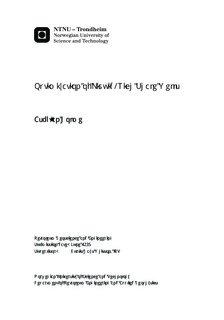| dc.description.abstract | The development of horizontal well technology and hydraulic fracturing have made production from shale and other low permeable rocks possible and revolutionized the oil and gas business. Shales produce typically with very low oil-gas ratios (high gas-oil ratios). For liquid-rich shales, it is shown that there is a significant difference between the initial solution oil-gas ratio and producing oil-gas ratio. In fact, what you produce at the surface is not the same as what you have in the reservoir. Shale wells produce with a low bottomhole pressure to maximize early gas rates and early rate of return. This comes with a drawback of reduced oil recovery. The combination of horizontal wells with hydraulically induced fractures and low permeability reduces the producing oil-gas ratio significantly compared to the initial in-solution oil-gas ratio. For liquid-rich shale gas condensate wells, the majority of the oil that is produced are produces as oil that is in solution in the gas phase. Little or no oil are produced as free oil. The fractures creates large volumes for the hydrocarbons to flow through and as the pressure drops below the dewpoint pressure near the wells, the build up of oil saturation is insufficient to become mobile oil in the near-fracture region. Most of the oil that condenses out of solution in the near-fracture region, are therefore unproduced resulting in a significant lower producing oil-gas ratio than the initial solution oil-gas ratio. The producing oil-gas ratio is directly linked to the producing bottomhole pressure. As the majority of the oil are produced as solution oil, the producing oil-gas ratio as a function of bottomhole pressure, will behave similar to the in solution oil-gas ratio of the fluid as a function of pressure. At higher pressures the gas contains more oil, and hence producing at a higher bottomhole pressure the gas will contain more oil as it is produced to the well resulting in a higher oil-gas ratio. \par Producing at a bottomhole pressure equal to the dewpoint pressure eliminates the effect of lost oil in the near-well region and the producing oil-gas ratio are therefore equal to the initial solution oil-gas ratio. Producing at a higher bottomhole pressure will come at the cost of reduced gas production. As oil is a more valuable commodity, the increased oil recovery at the expense of reduced gas recovery will in fact increase the net present value of the well. Optimizing the production in terms of finding the right bottomhole pressure may double the oil recovery of the well and increase the net present value of the revenues from the oil and gas sale by as much as 25 \%. Even though the increased oil recovery come at the expense of reduced gas recovery, the gas is not lost. When the rates at producing at a high bottomhole pressure are not economical anymore, the bottomhole pressure can be lowered. The gas production then quickly catches up with the production coming from a well that have produced at a constant low bottomhole pressure. This thesis show that producing at a higher bottomhole pressure is the best economical choice for a wide range of cases. It is applicable for all gas condensate systems as well as near-critical and volatile oil systems. A significant low permeability as well as a significant degree of undersaturation (high initial pressure) are required for the method to be economical beneficial. | nb_NO |

